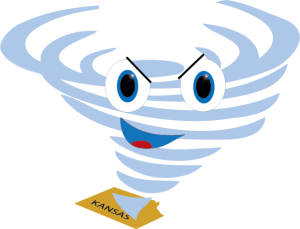By Ashley Hocking
Subzero temperature records were shattered in first weekend of January when the cold reached a new low. A frigid whirlpool of dense air, known as a polar vortex, gripped the nation when the core of the vortex shifted downward from its usual home in the Arctic region.
“It’s not a new word for any meteorologist, but the term sure did catch on in the public the last couple weeks,” said Erin Little, a meteorologist from KMBC 9 News. “From the moment we saw the dangerous cold in the forecast, we tried to warn the public as much as possible. Public safety is the most important part of my job.”
USD 497 students enjoyed an extended winter break when school was canceled Jan. 6 due to safety concerns with frigid temperatures.
The cold dipped to -10° degrees, which was the lowest recorded local temperature in the past 20 years. When wind chills reach -15°degrees, frostbite and hypothermia can develop on exposed skin within ten minutes.
While some students stayed indoors, others picked up a shovel and seized the opportunity to make extra cash. Junior Christian Espinosa operates a snow shoveling business during the winter to help out the elderly and families who are unable to do it themselves.
“It was about an eight-hour day and 11 degrees when we started,” Espinosa said. “I wore about five shirts, and I [had] to pull out the long underwear.”
On average, he earns $25 per driveway. On Jan 6, he racked up more than $200 in one day.
But, snow shovelers aren’t the only ones affected. Many employees whose jobs involve outdoor labor were also impacted by icy obstacles.
Senior Nick Lewis, a courtesy clerk at Hy-Vee on 23rd Street, braved the cold as he pushed carts in the parking lot in nothing but khakis and a light company jacket.
“It’s expected,” Lewis said. “Carts, bagging, cleaning, it’s all part of the job. You don’t get paid extra for going out in the cold.”
When ice covers the gravel of the parking lot, precaution is a necessity.
“I just have to be really careful,” Lewis said. “If there’s ice, I have to make sure I don’t slip because if I slip, the carts will go everywhere and hit cars. That’s a mess.”
But nearly as soon as temperatures reached dangerous levels, the outside temperatures began to climb steadily.
“I was glad because I don’t like the cold. It makes my eyes hurt and tears come out,” senior Jack Clark said. “It also makes my hair freeze.”
Some experts theorized the polar vortex was due to global warming, though it has not been proven.
Because the Arctic region is experiencing a warmer climate than usual, the ice is melting and a larger surface area of water is being created.
“On occasion, this air mass can dip much well into the United States, just like it did a couple weeks ago,” Little said. “Colder air [masses] can always dip into our area.”
This is not the first time the borders have shifted. However, the vortex’s boundaries rarely shift this drastically.
While the United States is experiencing the coldest winter in 20 years, the other side of the globe is encountering the polar opposite: a summertime heat wave. In Sydney, Australia, temperatures have peaked to 114° degrees this year.
The worst is over for now, but that does not mean the polar vortex is gone for good. Though the dangerous cold the polar vortex brought this winter was rare, it has happened before.
“It’s Kansas, so pretty much anything could happen,” Espinosa said.



